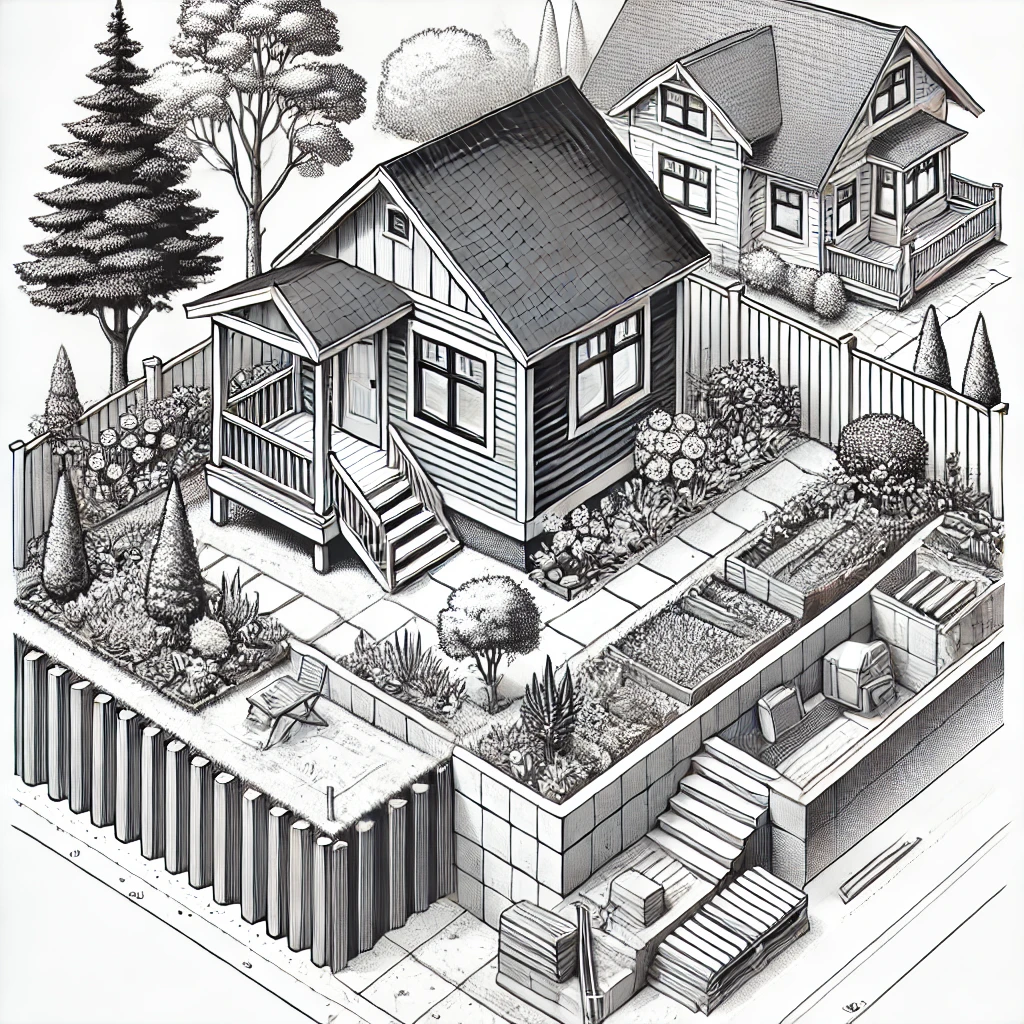Retaining walls are often essential for ADU projects, especially when dealing with sloped terrain.
These structures provide critical support, prevent soil erosion, and enhance the landscape, ensuring that your ADU (Accessory Dwelling Unit) is stable and safe.
Let’s explore the important details you need to know about retaining walls for ADUs.
What is a Retaining Wall?
A retaining wall is a structure designed to hold back soil and stabilize the landscape.
They’re basically used to create level surfaces on slopes or difficult terrain, which is where they come in handy for ADU builds.
Without a retaining wall, problems from shifting soil can become a significant issue.
Types of Retaining Walls
A lot of people don’t realize that there are actually several types of retaining walls that are used in different instances.
Gravity Walls
These rely on their own weight to hold back the soil.
They are usually made from heavy materials such as stone or concrete, which makes a lot of sense when you think about it.
Cantilevered Walls
These walls use reinforced concrete and have a lever arm structure that helps to bear the load.
Sheet Pile Walls
These are made from steel, wood, or vinyl, driven deep into the ground, and are best for soft soils and tight spaces.
Anchored Walls
These utilize cables or other stays anchored into the rock or soil behind the wall for additional support.
Each type has unique benefits and considerations, depending on the specific requirements of your ADU project.
Always consult a professional when deciding the best retaining wall for your project.
Materials Used
Retaining walls can be constructed from various materials, each offering different advantages:
- Concrete: Highly durable and versatile, concrete is suitable for most retaining wall applications in ADU projects.
- Stone: Stone walls can be expensive, but a lot of people love the natural look.
- Brick: Bricks are also super popular and very durable.
- Timber: Timber is quite rare and can have durability issues, plus the high prices of timber in recent years can make this option less attractive.
Choosing the right material for your retaining wall involves balancing budget, aesthetic preferences, and the specific structural needs of your ADU.
Design
Designing a retaining wall requires serious professional assistance.
You may think it’s straightforward, but that is far from the truth.
You need to consider things like the height of the wall, the soil type and how it drains, as well as the slope of the existing landscape.
Building Permits and Regulations
Before constructing a retaining wall, you need to check your local building codes and regs to get it approved.
In most cases, you’ll need a permit if your wall is over a certain height or supporting a certain weight.
The Construction Process Explained
Building a retaining wall is not as straightforward as building a regular wall, especially when large loads or heights come in play.
The basic process (once approved) is to excavate the site, lay a foundation, and then construct the wall.
Once built, it can be backfilled and a drainage system added.
Maintenance Tips
Retaining walls need a bit of care to last for years and look good.
You should inspect the wall every so often for signs of wear and tear, and make repairs when necessary. It’s also important to make sure that any plants or grass isn’t causing damage, and that the drainage is kept clear so it can keep doing its job.
Consistent maintenance extends the lifespan of your retaining wall and ensures it continues to support your ADU effectively.
Cost Considerations
The cost of building a retaining wall for an ADU can vary significantly based on several factors.
These include the material used – for example, stone and brick usually cost more than concrete or timber. Height and length considerations also come into play, as well as the site conditions and the complexity of the design.
Budgeting for these factors helps you plan effectively and manage your project’s finances. On average, you’re looking at $20 to $50 per square foot ($40 to $300 per linear foot).
FAQs
Why are retaining walls important for ADUs?
Retaining walls provide critical structural support, create level building surfaces, and prevent soil erosion, which is essential for ADUs on sloped lots.
What materials are best for retaining walls in ADUs?
Concrete, stone, brick, and timber are common materials, each offering unique benefits in terms of durability, aesthetics, and cost.
Do retaining walls require maintenance?
Yes, regular inspections and maintenance are necessary to ensure the wall’s stability and longevity, especially in supporting an ADU.
Are permits required to build retaining walls for ADUs?
In the majority of cases, yes.
Always check your local building regs to see what the requirements are in your area.
Wrapping It Up
Retaining walls are not needed for all ADU projects, but if you need to build one, it’s very important to hire an expert to make sure it’s done right.
When done properly, a retaining wall should not only support the construction of your ADU, but also add to the aesthetic as well.
